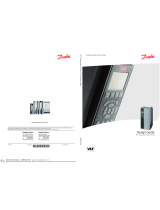
CE Conformity and Labelling
What is CE Conformity and Labelling?
The purpose of CE labelling is to avoid technical trade obstacles within EFTA and the EU. The EU has
introduced the CE label as a simple way of showing whether a product complies with the relevant EU
directives. The CE label says nothing about the specifications or quality of the product. Frequency con-
verters are regulated by three EU directives:
The machinery directive (98/37/EEC)
All machines with critical moving parts are covered by the machinery directive of January 1, 1995. Since
a frequency converter is largely electrical, it does not fall under the machinery directive. However, if a
frequency converter is supplied for use in a machine, we provide information on safety aspects relating
to the frequency converter. We do this by means of a manufacturer's declaration.
The low-voltage directive (73/23/EEC)
Frequency converters must be CE labelled in accordance with the low-voltage directive of January 1,
1997. The directive applies to all electrical equipment and appliances used in the 50 - 1000 V AC and the
75 - 1500 V DC voltage ranges. Danfoss CE-labels in accordance with the directive and issues a decla-
ration of conformity upon request.
The EMC directive (89/336/EEC)
EMC is short for electromagnetic compatibility. The presence of electromagnetic compatibility means that
the mutual interference between different components/appliances does not affect the way the appliances
work.
The EMC directive came into effect January 1, 1996. Danfoss CE-labels in accordance with the directive
and issues a declaration of conformity upon request. To carry out EMC-correct installation, see the in-
structions in this Design Guide. In addition, we specify which standards our products comply with. We
offer the filters presented in the specifications and provide other types of assistance to ensure the opti-
mum EMC result.
The frequency converter is most often used by professionals of the trade as a complex component forming
part of a larger appliance, system or installation. It must be noted that the responsibility for the final EMC
properties of the appliance, system or installation rests with the installer.
What Is Covered
The EU "Guidelines on the Application of Council Directive 89/336/EEC" outline three typical situations of
using a frequency converter. See below for EMC coverage and CE labelling.
1. The frequency converter is sold directly to the end-consumer. The frequency converter is for
example sold to a DIY market. The end-consumer is a layman. He installs the frequency converter
himself for use with a hobby machine, a kitchen appliance, etc. For such applications, the fre-
quency converter must be CE labelled in accordance with the EMC directive.
2. The frequency converter is sold for installation in a plant. The plant is built up by professionals
of the trade. It could be a production plant or a heating/ventilation plant designed and installed
by professionals of the trade. Neither the frequency converter nor the finished plant has to be CE
labelled under the EMC directive. However, the unit must comply with the basic EMC require-
ments of the directive. This is ensured by using components, appliances, and systems that are
CE labelled under the EMC directive.
3. The frequency converter is sold as part of a complete system. The system is being marketed as
complete and could e.g. be an air-conditioning system. The complete system must be CE labelled
in accordance with the EMC directive. The manufacturer can ensure CE labelling under the EMC
directive either by using CE labelled components or by testing the EMC of the system. If he
chooses to use only CE labelled components, he does not have to test the entire system.
FC 300 Design Guide
Introduction to FC 300
14 MG.33.B7.02 - VLT is a registered Danfoss trademark























